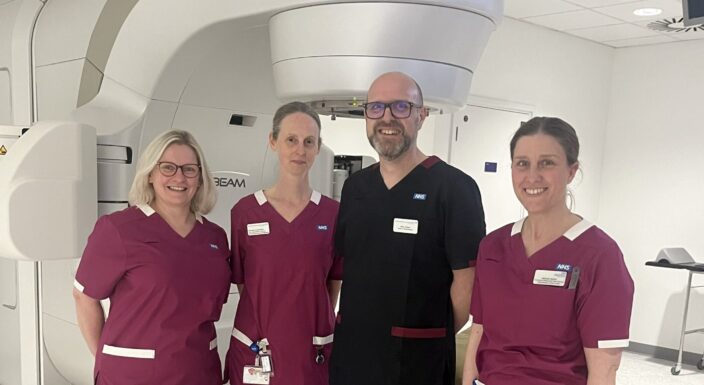
Spotlight on our Therapeutic Radiographers
Radiotherapy is a key part of cancer treatment, delivered through a team effort involving consultant clinical oncologists, clinical scientists, and therapeutic radiographers.
At NNUH therapeutic radiographers play a vital and evolving role in delivering high-quality, patient-centred care to approximately 3000 patients every year.
Therapeutic Radiographers are the only healthcare professionals trained specifically in cancer care, with expertise in radiation physics, radiotherapy technology, anatomy, physiology and emotional support. Our team includes therapeutic radiographers at all stages of their careers, with opportunities to progress into enhanced, advanced, consultant-level, and specialist leadership roles.
Therapeutic radiographers are increasingly supporting clinical oncologists by taking on responsibilities such as carefully identifying and marking the exact part of the body that needs treatment and supporting patients in therapeutic radiographer-led clinics. This allows both clinical oncologists and therapeutic radiographers to work efficiently and progress the patient through their radiotherapy pathway. The therapeutic radiographers remain the most consistent point of contact for patients, combining technical precision with compassionate care.
Every patient receiving radiotherapy has a planning CT scan to create a 3D digital model of the treatment area. Therapeutic radiographers use this to prepare a computerised plan which is later used to deliver the prescribed radiation dose to the targeted volume, whilst limiting dose to healthy tissue. These plans are reviewed by clinical scientists and approved by consultants before being delivered by therapeutic radiographers on the linear accelerators.
We are at the forefront of innovation in radiotherapy. AI software helps outline healthy tissue quickly and accurately on the planning CT scan, requiring just a check by the therapeutic radiographer or consultant. Surface Guided Radiotherapy (SGRT) helps the therapeutic radiographers quickly and accurately position patients for treatment and automatically pauses treatment if they move. Upcoming SGRT technologies will further improve planning and allow therapeutic radiographers to visualise how X-rays interact with the body, placing us at the cutting edge of clinical development and research.
Therapeutic radiographers play a central role in both the radiotherapy planning and treatment delivery at the Colney Centre, working across the Waxham and Winterton units. In addition to these responsibilities, they lead dedicated review clinics where they assess patients undergoing radiotherapy, help manage treatment-related side effects, prescribe medications, and provide tailored support to aid recovery. These clinics are delivered in collaboration with a multidisciplinary team, including dietitians and speech and language therapists, ensuring holistic care. A pilot late effects clinic, sponsored by the Cancer Alliance, is also underway to support patients experiencing long-term consequences of treatment. Mark Gilham, Head of Radiotherapy said: “Early feedback indicates that this service is effective and highly valued by patients.”
The team also delivers a world-renowned Brachytherapy service from a dedicated theatre suite. Brachytherapy is a form of internal radiotherapy used to treat some prostate and gynaecological cancers. In addition, the department operates an Xstrahl Superficial Treatment machine, which is specifically designed for treating skin cancers. Unlike linear accelerators which deliver radiation deep into the body, the Superficial machine targets the surface, making it ideal for managing skin-based malignancies.
To help patients feel informed and reassured, the department runs open evenings supported by the N&N Hospital Charity, including tours and visits to the Big C centre.
“It’s about providing the patients and their loved ones with as much reassurance as possible,” said Mark.
NNUH supports multiple routes into the profession, including student placements and apprenticeships. The department has close links with the University of Suffolk, Hertfordshire University and Sheffield Hallam University, each have learners in the radiotherapy department.
Mark added: “We are seeing more cancer patients, which means our consultant clinical oncologists have increasingly high workloads. Therapeutic radiographers are supporting oncologists by taking on additional competencies and responsibility. Therapeutic radiographers at NNUH are specialising in key body sites or the use of specific technologies, and by doing this, we’re improving efficiency and patient outcomes.
“Therapeutic radiographers are not only delivering cancer treatment, but are also leading innovation, supporting patients holistically, and shaping the future of radiotherapy services.”


